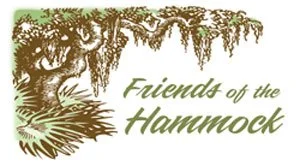Plant Life In The Hammock
By Glenn Fleming, member of Dunedin’s Hammock Advisory Committee
September 1981 — Updated May 1986
Enter any of the main trails of The Hammock and you are impressed by the majesty of the high canopy of trees, some of them 100 or more years old and with diameters up to three feet. The filtered shade of this old forest gives a sense of solitude and tranquillity.
In 1976, Glenn Fleming and the late Pierre Genelle, assistant curators at the University of South Florida Herbarium, Tampa, undertook a plant inventory of The Hammock (in cooperation with the Dunedin Garden Club and the Dunedin Recreation and Parks Department). The results of their work were published in CASTANEA, a scientific journal on the botany of the southeastern states. Reprints of the article are on file at the Dunedin Public Library.
Three hundred thirty-six species from 100 plant families were collected and identified. Since then, Fleming has identified an additional 20 species. The plant inventory supplements and updates previous studies made by students from the Clearwater Campus of St. Petersburg Junior College and by the late Dr. Bernard Raymund of the St. Petersburg Audubon Society.
In its 85 acres, The Hammock contains a hardwood forest, a rarity in this section of Florida; a salt water estuary; fresh water ditches; and a dry, white sand scrub area. There are six definite plant habitats, based on soil type, moisture, and vegetation communities. The diversity of habitats accounts for the large number of species in such a small area. The six habitats and their locations are:
1) Disturbed Sites — From the entrance through the picnic area and along the roads, ditches, and trails. They are populated by grasses, sedges, and numerous common weeds.
2) Mangrove / Salt Grass — The Cedar Creek estuary and salt flat in the north section of The Hammock. The soil is brackish muds. Black and white mangroves, marsh elder, Brazilian pepper, saltwort, rushes, and salt grasses flourish there.
3) Oak / Pineland — Sandy loam soil characterizes the north section and scattered locations in the large south section of The Hammock. The leading canopy trees are laurel oak, live oak, sugarberry, slash pine, and southern red cedar. The understory is cabbage palm, laurel cherry, and wax myrtle. There are numerous camphor trees in the north section. The ground cover is ferns and wild coffee.
4) Hardwoods — Palm Trail and Live Oak Trail areas illustrate this habitat. The soil is mucky. The canopy trees are sugarberry, live oak, hickory, red maple, and sweet bay. The understory trees are cabbage palm and citrus. (The citrus probably was planted by a previous owner of the property in openings created by hurricane blow-downs.) The ground cover is ferns.
5) Bayheads — The northeast and southwest corners of the large south section. The soils are muck and loam. Canopy trees are sweet bay, loblolly bay, red bay, and red maple. The understory is elderberry, wax myrtle, and swamp dogwood. The ground cover is ferns, lizard’s tail, terrestrial orchids, and jack-in-the-pulpit.
6) Sand Pine / Scrub Oak — The southeast corner of the south section. The soil is white sand. Dominant species are sand pine, sand live oak, myrtle oak, saw palmetto, deer berry, pawpaw, camphorweed, greenbrier and wild grapevines.
The canopy trees throughout The Hammock contain may epiphytes (orchids, bromeliads, and resurrection ferns) which do not harm the trees and add to the charm of the forest. Parasitic mistletoe (which is harmful) can be seen in the trees in the picnic area. A special delight is the ground cover of 16 species of ferns, ranging from the common bracken and Boston fern to the giant leather fern and the elegant royal fern.
Two groups of plants cause problems in maintaining The Hammock in its natural state. Woody vines (wild grape and greenbrier) smother the trees and shrubs and add great mass endangering the host when a strong wind blows. Exotic species (Brazilian pepper, Solanum diphyllum, and castor bean) are too successful and tend to crowd out the native plants. The City of Dunedin has a program under way to control these problem species.
